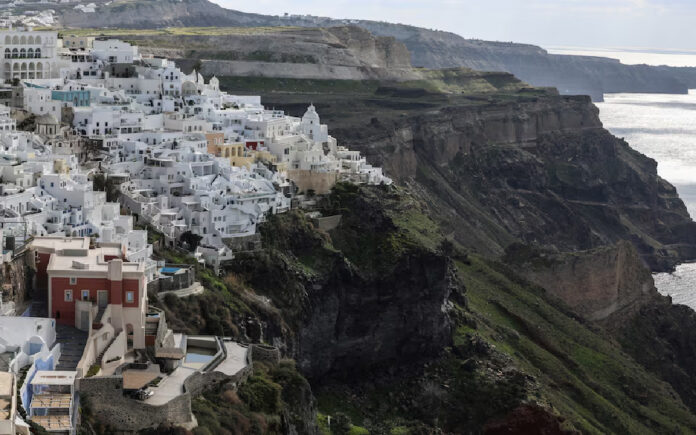Santorini: A series of small earthquakes rattling Greece’s tourist hotspot, Santorini, this week has reignited concerns over the safety of the island’s decades-long construction surge along its steep volcanic cliffs.
Although no severe damage has been reported, scientists caution that the seismic activity could persist for weeks, leaving open the possibility of a stronger quake. This has intensified fears among experts, who have long questioned the sustainability of turning the picturesque island into one of Europe’s most sought-after travel destinations.
Concerns Over Construction on Volcanic Slopes
Dimitris Papanikolaou, a geology professor at the University of Athens and former head of Greece’s Earthquake Planning and Protection Organisation, criticized past development choices, warning that the island’s fragile terrain was ill-suited for large-scale construction.
“They wanted to develop the island and didn’t pay attention to environmental and safety issues,” he said. The result, he noted, is luxury hotels and pools precariously perched on landslide-prone slopes of soft volcanic soil.
“Nothing should have been built in this zone,” he added. “It’s a danger zone for as long as the seismic activity lasts.”
The tremors prompted authorities to declare a state of emergency on Thursday. Schools were shut, the army was deployed, and thousands of people evacuated via flights and ferries. Officials also issued landslide warnings for five key areas, including Santorini’s main port, and restricted access to sections of the caldera—the steep cliffs forming the rim of the ancient, submerged volcano.
Tourism Boom Meets Seismic Reality
Santorini has long struggled with the impact of mass tourism, which has led to water shortages, overcrowding, and infrastructure strain. Despite being a small island, it attracts millions of visitors each year, drawn by its iconic blue-domed churches and whitewashed streets.
The island’s vulnerability to natural disasters is well-documented. The current landmass was shaped by a volcanic eruption in 1600 BC, and a devastating earthquake in 1956 reshaped its landscape. A rapid building boom in the 1980s sought to revive tourism, but concerns over structural safety have persisted.
In 2021, a report by the Hellenic Society for Environment and Cultural Heritage, commissioned by Santorini’s local authorities, underscored the urgent need for a soil engineering study to assess building safety along the caldera. Citing data from the Technical Chamber of Greece, the report revealed that many buildings lacked proper permits, with nearly a quarter of them being tourism-related businesses.
Also Read | IMF Warns of Slower Economic Growth in Nicaragua as Remittances Decline
“It is crucial… to immediately check the arbitrary construction taking place within the caldera,” the report stated.
Government Response and Industry Concerns
The Greek environment ministry imposed a one-year construction freeze on the caldera in November, requiring property owners to complete risk assessments or face permit revocation, according to Dimitris Bakoyiannis, Secretary General for Spatial Planning and Urban Environment.
During a visit to Santorini on Friday, Prime Minister Kyriakos Mitsotakis urged calm and defended Greece’s construction standards, stating, “We have a very strict building code which is applied across the country, especially in those areas that are more earthquake-prone. That’s why we feel very, very confident that everything that could be done, has been done.”
Despite reassurances, local business owners remain anxious. Many residents have grown accustomed to tremors, but the intensity of the past week has raised fears about potential economic fallout.
Also Read | Flu Season Worsens in US, Reaching Highest Infection Rate in 15 Years
Mathaios Kourgialis, a hotel owner atop the caldera, reported multiple booking cancellations in recent days.
“If we continue for another couple of months with this situation, the season will be lost,” he said.



